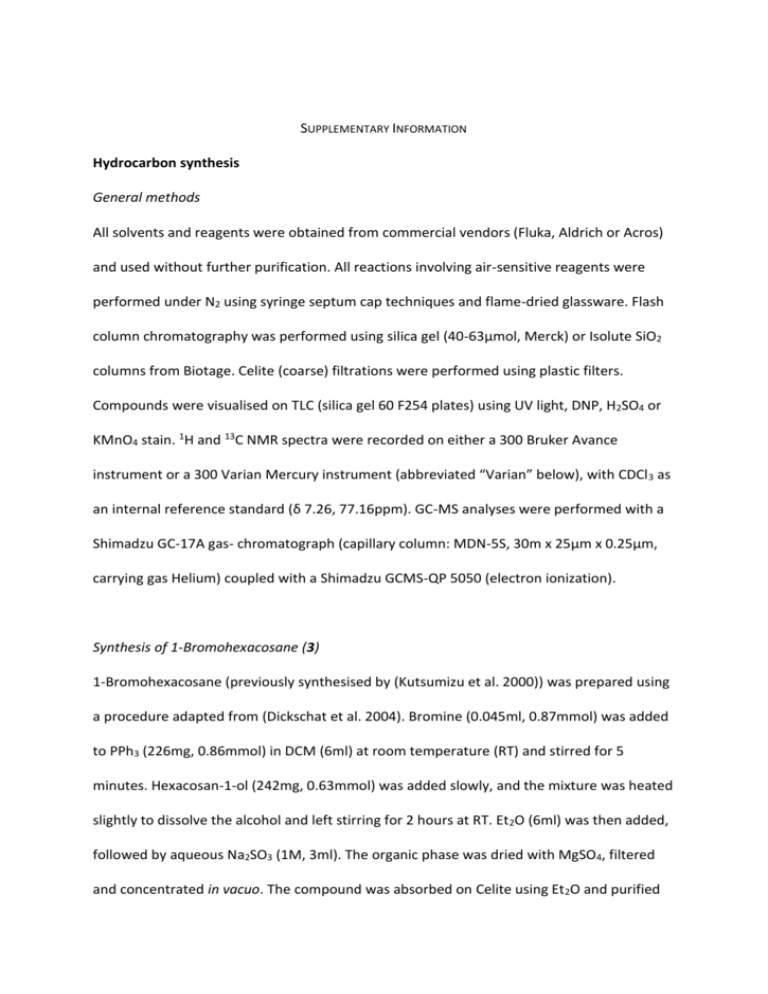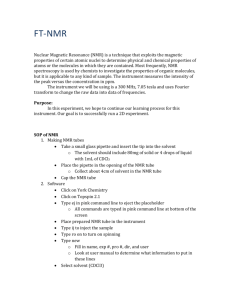Supplementary methods, fig and table
advertisement

SUPPLEMENTARY INFORMATION Hydrocarbon synthesis General methods All solvents and reagents were obtained from commercial vendors (Fluka, Aldrich or Acros) and used without further purification. All reactions involving air-sensitive reagents were performed under N2 using syringe septum cap techniques and flame-dried glassware. Flash column chromatography was performed using silica gel (40-63μmol, Merck) or Isolute SiO2 columns from Biotage. Celite (coarse) filtrations were performed using plastic filters. Compounds were visualised on TLC (silica gel 60 F254 plates) using UV light, DNP, H2SO4 or KMnO4 stain. 1H and 13C NMR spectra were recorded on either a 300 Bruker Avance instrument or a 300 Varian Mercury instrument (abbreviated “Varian” below), with CDCl 3 as an internal reference standard (δ 7.26, 77.16ppm). GC-MS analyses were performed with a Shimadzu GC-17A gas- chromatograph (capillary column: MDN-5S, 30m x 25μm x 0.25μm, carrying gas Helium) coupled with a Shimadzu GCMS-QP 5050 (electron ionization). Synthesis of 1-Bromohexacosane (3) 1-Bromohexacosane (previously synthesised by (Kutsumizu et al. 2000)) was prepared using a procedure adapted from (Dickschat et al. 2004). Bromine (0.045ml, 0.87mmol) was added to PPh3 (226mg, 0.86mmol) in DCM (6ml) at room temperature (RT) and stirred for 5 minutes. Hexacosan-1-ol (242mg, 0.63mmol) was added slowly, and the mixture was heated slightly to dissolve the alcohol and left stirring for 2 hours at RT. Et2O (6ml) was then added, followed by aqueous Na2SO3 (1M, 3ml). The organic phase was dried with MgSO4, filtered and concentrated in vacuo. The compound was absorbed on Celite using Et2O and purified by flash column chromatography (Isolute, 20g, pentane/Et2O 7:0 – 7:1), yielding 282mg of 1bromohexacosane. 1H NMR (CDCl3) δ 0.88 (t, J=7Hz, CH3, 3H), 1.26-1.54 (m, (CH2)n, 46H), 1.81-1.90 (m, CH2, 2H), 3.41 (t, J=7Hz, CH2Br, 2H). 13C NMR (CDCl3) δ 14.3, 22.9, 28.4, 28.9, 29.5, 29.6, 29.7, 29.9, 32.1, 33.0. Synthesis of 5-Hexacosyl-2,3-dimethylthiophene (4) n-BuLi in hexanes (0.85ml, 1.3mmol, 1.6M) was added to 2,3-dimethylthiophene (154mg, 1.37mmol) dissolved in THF (4ml) at RT. The mixture was stirred while 3 (282mg, 0.63mmol) in THF (5ml) was added dropwise, then left to stir over night at RT. Saturated aqueous NH 4Cl was added and the mixture extracted with Et2O (3x), washed with brine, dried with Na2SO4 and concentrated in vacuo. Column chromatography (Isolute SiO2, 5g, 100% pentane) gave two major fractions: Fraction 1 (217mg) with 3 present (~ 5mol%) and fraction 2 (50mg) with pure 4 estimated by 1H NMR and GC-MS and visualised by TLC (H2SO4). TLC (100% pentane) Rf 0.86. (1-bromo-n-hexacosane: Rf 0.94). 1H NMR of fraction 2 (CDCl3) δ 0.88 (t, J=7Hz, CH3, 3H), 1.25 (m, (CH2)n, 48H). 2.06 (s, ArCH3, 3H), 2.28 (s, ArCH3, 3H), 2.67 (t, J=7Hz, ArCH2, 2H), 6.44 (s, ArH, 1H). 13C NMR (Varian, CDCl3) δ 13.2, 13.8, 14.4, 23.0, 29.4, 29.6, 29.7, 29.8, 30.0, 30.2, 32.0, 32.2, 126.9, 129.8, 132.3, 141.0. GC-MS 125, 476. Synthesis of (R/S)-3-Methylhentriacontane (1) 3-Methylhentriacontane (3-MeC31) has previously been described from alkane mixtures from various natural sources (e.g. Kaneda 1967; FinidoriLogli et al. 1996; Akino 2006; Dreier & d'Ettorre 2009) and synthesised as part of a mixture of compounds (Cope et al. 1965). A solution of 4 (48mg, 0.1mmol) in dioxane (1ml) was bubbled through with N2 for five minutes, whereupon aqueous Raney Ni (0.5ml of a 50% slurry) was added. The slurry was refluxed overnight, cooled to RT and filtered through a Celite column using dioxane and pentane. The clear filtrate was concentrated in vacuo (43mg) and checked by NMR to see disappearance of aromatic protons. The resulting desulfurised product (43mg) in a 1:1 mixture of EtOH/heptane (5ml) was stirred with 5% Pd/C (19mg) under an atmosphere of H 2 at an oil bath temperature of 40ºC over night. The mixture was filtered through Celite using pentane. The filtrate was concentrated in vacuo and filtered through an Isolute SiO2 column (5g) with pentane giving 1 as a white wax (39mg, 95%). 1H NMR (CDCl3) δ 0.82-0.90 (m, 3xCH3, 9H), 1.05-1.52 (m, (CH2)n, 57H). 13C NMR (CDCl3) δ 11.6, 14.3, 19.4, 22.9, 27.3, 29.5, 29.7, 29.8, 29.9, 30.2, 32.1, 34.6, 36.8. GC-MS 57, 71, 85, 99, 113, 141, 155, 169, 183, 197, 211, 225, 253, 267, 281, 421 [M-C2H5]+. (R/S)-1-(3-Methylthiophen-2-yl)tricosan-1-ol (5) 1-Bromodocosane (5.82g, 15mmol) in Et2O (8ml) was added to magnesium (547mg, 22.5mmol) suspended in Et2O (10ml). Approximately 0.1ml of 1,2-dibromoethane was added and the mixture was heated for 1h, before 3-methylthiophene-2-carbaldehyde (1.20g, 9.5mmol) was added. The mixture was left stirring overnight at RT. Saturated aqueous NH4Cl (5ml) was added and the mixture was left stirring for 15 min followed by addition of H2O (10ml). The solvent was decanted and the filter cake was washed several times with Et2O. The mixture was concentrated followed by purification using flash column chromatography giving 5 (765mg, 18%). TLC (heptane/EtOAc 4:1) Rf 0.4. 1H NMR (CDCl3) δ 0.88 (t, J=7Hz, CH3, 3H), 1.25-1.88 (br, (CH2)n, OH, 42H), 2.23 (s, CH3, 3H), 4.97 (t, J=7Hz, ArCHOH, 1H), 6.79 (d, J=5Hz, ArH, 1H), 7.15 (d, J=5Hz, ArH, 1H). 13C NMR (Varian, CDCl3) δ 14.1, 14.4, 23.0, 26.2, 29.6, 29.7, 29.77, 29.82, 29.88, 29.91, 30.0, 32.2, 39.4, 68.6, 123.0, 130.0, 133.4, 142.0. GC-MS 111, 124, 137, 418 [M-H2O]+. 3-Methyl-2-tricosylthiophene (6) Compound 6 was prepared using a procedure adapted from (Lau et al. 1986). ZnI2 (511mg, 1.6mmol) was added to a solution of 5 (436mg, 1.0mmol) in 1,2-DCE (30ml) at RT, whereupon the mixture turned slightly pink.NaBH3CN (471mg, 7.5mmol) was added and the mixture turned colourless. After two days stirring at RT, the mixture was filtered on Celite and the filter cake was washed with additional DCM. Flash column chromatography (heptane/Et2O 100:0 – 20:1) yielded 6 as a solid wax (320mg, 76%). TLC (100% heptane) Rf 0.57. 1H NMR (CDCl3) δ 0.88 (t, J=7Hz, CH3, 3H), 1.26-1.64 (m, (CH2)n, 42H), 2.15 (s, CH3, 3H), 2.70 (t, J=8Hz, ArCH2, 2H), 6.77 (d, J=5Hz, ArH, 1H), 7.00 (d, J=5Hz, ArH, 1H). 13C NMR (CDCl3) δ 13.7, 14.3, 22.9, 28.0, 29.45, 29.52, 29.6, 29.7, 29.82, 29.86, 31.7, 32.0, 32.1, 120.9, 130.0, 132.4, 139.1. GC-MS 111, 420 [M]+. (R/S)-3-Methylheptacosane (2) This compound (3-MeC27) has been previously described from a mixture of alkanes isolated from natural sources or synthesised as the R- or S-enantiomer (FinidoriLogli et al. 1996; Marukawa et al. 2001). Compound 2 was prepared according to the procedure described for compound 1 starting with 6 (198mg, 0.5mmol), dioxane (4ml) and Raney Nickel (4.2g of 50% slurry) giving a desulphurised mixture (175mg), which was further treated with Pd/C (57mg) and H2 (1 atm) at 40ºC in a 1:1 mixture of heptane/EtOH (20ml) overnight. Flash column chromatography (100% pentane) of the filtered compound yielded 2 as a white wax (156mg, 84%). 1H NMR (CDCl3) δ 0.88 (m, 3xCH3, 9H), 1.07-1.55 (m, (CH2)n, 49H). 13C NMR (CDCl3) δ 11.7, 14.4, 19.5, 23.0, 27.4, 29.6, 29.7, 29.9, 30.3, 32.2, 34.6, 36.9. GC-MS 57, 71, 85, 99, 113, 127, 141, 155, 169, 183, 197, 211, 225, 253, 267, 281, 337, 365 [M-C2H5]+. SUPPLEMENTARY INFORMATION REFERENCES Akino, T. 2006 Cuticular hydrocarbons of Formica truncorum (Hymenoptera: Formicidae): Description of new very long chained hydrocarbon components. Applied Entomology and Zoology 41, 667-677. Cope, A. C., Burrows, E. P., Derieg, M. E., Moon, S. & Wirth, W. D. 1965 Rimocidin I: Carbon skeleton partial structure and absolute configuration at C-27. Journal of the American Chemical Society 87, 5452-&. Dickschat, J. S., Wenzel, S. C., Bode, H. B., Muller, R. & Schulz, S. 2004 Biosynthesis of volatiles by the myxobacterium Myxococcus xanthus. Chembiochem 5, 778-787. Dreier, S. & d'Ettorre, P. 2009 Social context predicts recognition systems in ant queens. Journal of Evolutionary Biology 22, 644-649. FinidoriLogli, V., Bagneres, A. G., Erdmann, D., Francke, W. & Clement, J. L. 1996 Sex recognition in Diglyphus isaea Walker (Hymenoptera: Eulophidae): Role of an uncommon family of behaviorally active compounds. Journal of Chemical Ecology 22, 2063-2079. Kaneda, T. 1967 Biosynthesis of long-chain hydrocarbons I: Incorporation of L-valine, Lthreonine, L-isoleucine and L-leucine into specific branched-chain hydrocarbons in tobacco. Biochemistry 6, 2023-&. Kutsumizu, S., Ichikawa, T., Yamada, M., Nojima, S. & Yano, S. 2000 Phase transitions of 4 '-n-hexacosyloxy-3 '-nitrobiphenyl-4-carboxylic acid (ANBC-26): Two types of thermotropic cubic phases. Journal of Physical Chemistry B 104, 10196-10205. Lau, C. K., Dufresne, C., Belanger, P. C., Pietre, S. & Scheigetz, J. 1986 Reductive deoxygenation of aryl aldehydes and ketones and benzylic, allylic, and tertiary alcohols by ZNI2-NaCNBH3. Journal of Organic Chemistry 51, 3038-3043. Marukawa, K., Takikawa, H. & Mori, K. 2001 Synthesis of the enantiomers of some methylbranched cuticular hydrocarbons of the ant, Diacamma sp. Bioscience Biotechnology and Biochemistry 65, 305-314. Table S1: Composition of the chemical profile of workers, queens and queen-laid eggs of Lasius niger. The stars denote compounds that make up a significantly different proportion of the profile of queens and workers (ANOVA; n = 20 workers and 20 queens); * = p < 0.05, ** = p < 0.01, *** = p < 0.001. Peak C25 C27:1 C27 3-MeC27 C29:1 C29 7-, 9-, 11- and 13-MeC29 5-MeC29 7,11-, 9,15- and 11,15-diMeC29 3-MeC29 5,15-diMeC29 5,9,13- and 7,11,15-triMeC29 12- and 14-diMeC30 10,14-diMeC30 C31:1 C31 7-, 9-, 11-, 13- and 15-MeC31 5-MeC31 7,17-, 9,15-, 9,17-,11,15- and 13,17-diMeC31 3-MeC31 5,13- and 5,17-diMeC31 7,13,17-triMeC31 3,9-, 3,11-, 3,13-, 3,15- and 3,19-diMeC31 10-, 14- and 15-MeC32 4-MeC32 and 10,14-diMeC32 C33:1 7-, 9-, 11-, 13-, 15- and 17-MeC33 11,15-, 13,17- and 15,19-diMeC33 9,15- and 11,17-diMeC33 3-MeC33 and 5,17- and 5,19-diMeC33 7,13,15- and 7,13,19-triMeC33 3,9-, 3,11- and 3,13-diMeC33 9,17-, 11,19-, 13,21- and 15,23-diMeC35 Workers % of profile Queens 0.4 0.2 0.9*** 0.2 0.9 2.1* 1.7** 7.6** 1.1 1.8*** 2.1*** 1.3*** 2.0 2.2 1.0 13.3*** 1.1 19.9*** 1.9 3.5*** 2.6*** 3.3*** 2.1*** 2.1 1.1 2.9 2.5 5.5 2.3 2.0*** 1.7*** 7.7*** 3.2*** 1.7 1.0 5.9 2.3*** 0.7 1.0 0.7 2.1 8.0*** 3.3*** 6.5 1.6 14.1 11.9*** 0.6 1.9 1.5 1.3 2.5 5.6*** 2.9 2.9 6.3 2.6 1.3 1.0 3.9 Eggs 0.7 0.6 5.5 1.3 2.6 7.1 1.2 8.2 2.3 8.4 2.6 1.8 0.4 0.9 11.7 3.4 8.2 4.3 5.2 17.3 0.7 1.0 1.3 0.4 0.4 2.3 SUPPLEMENTARY INFORMATION FIGURE LEGEND Figure S1: Ovary activation (on a scale of 1-4) in queenless groups of workers following supplementation with 3-MeC31, C31 or pentane. This is the same dataset as in Figure 1B, but split into the 6 individual colonies.





